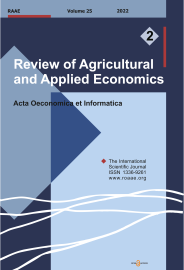KEYWORDS:
profitability; efficiency; bambara groundnut; production
DOI NUMBER:
10.15414/raae.2020.23.02.92-101
ABSTRACT:
Research Background: Although it is a highly nutritious and climate resistant crop, bambara groundnut is described as a neglected and under-utilized crop in most countries including Nigeria where its production is in the hands of some smallholder farmers. Empirical facts on the profitability as well as the technical efficiency of bambara groundnut production in Kogi state, Nigeria, where it serves as an important source of food and income, are unknown. These facts, when known, can draw the attention of stakeholders to intervention areas.Purpose of the article: The research was undertaken to provide factual data through empirical analyses on the cost, returns and technical efficiency of smallholder bambara groundnut farmers in the area, in to order elicit interest in the neglected crop. Such attention may aid in the expansion of the crop’s production through interventions in identified areas of concern.
Methods: A five-stage sampling technique was employed in the random selection of 120 farmers for questionnaire administration in order to obtain the requisite data. Data on cost and returns were subjected to Gross Margin and Net Return on Investment analyses while the Cobb-Douglas Stochastic Frontier Production Function was employed in analysing technical efficiency.
Findings and value added: Producers of bambara groundnut in the area are small scale farmers who are old, poorly educated and have large families. Cost and returns analysis showed that labour had the highest percentage of Total Variable Cost (78.00%). The venture, with a gross margin of -11,601.87 Nigerian Naira (-60.31 USD) and Net Returns on Investment of 0.79, is unprofitable. Experience and education affect the moderately high technical efficiency level which on the average is 71.2%. Bambara groundnut production in the area can be made profitable through labour cost reduction and improvement in average efficiency level by 28.8%. The provision of machinery to help reduce labour cost, in addition to special policy attention that will enhance improvements in education and extension services will reduce inefficiency and improve profitability.
Please Cite this Article as:
Unekwu ONUCHE, Stephen Jimoh IBITOYE, Thomas ANTHONY (2020) Profitability And Efficiency Of Bambara Groundnut Production In Nigeria: A Case Study. Review of Agricultural and Applied Economics. XXIII (Number 2, 2020): 92-101. doi: 10.15414/raae.2020.23.02.92-101
URL for sharing:
https://roaae.org/1336-9261/doi/abs/10.15414/raae.2020.23.02.92-101
FULL TEXT PDF:
▼ direct download link| view online in fullscreen ▲
References:
▼ direct download link

